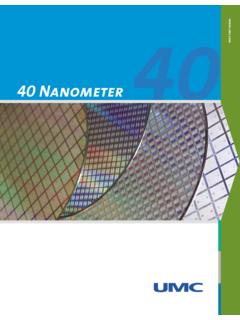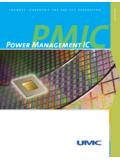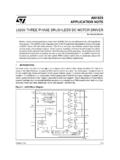Transcription of FO UN DR Y LEADERSHI P FOR TH E SoC GENER AT ION 65
1 65 FOUNDRY LEADERSHI P FOR THE SoC Nanometer 65 NanometerUMC is the foundry leader in 65nm process technology, having delivered the foundry industry s first 65nm customer products in June of 2005. UMC's 65-nanometer SoC solution begins with a flexible technology design platform. Customers are able to choose the process device options that are optimized for their specific application, such as Standard Performance (SP), Low Power(LP) or Low Leakage (LL) transistors. The high performance characteristics of UMC s 65nm SP process enable designers to utilize the technology to power a broad range of applications from consumer products to graphics ICs. Technology options can then be implemented including mixed signal/RFCMOS and embedded memories to further customize the process.
2 Integrated flows for logic , Mixed-Signal/RF 6T/8T e-SRAM bit cells; URAMTM option ( ) e-Fuse option Shallow trench isolation Retrograde twin well (Triple well option) 193nm litho for all critical layers Enhanced nitrided gate oxide 40nm min. poly length Multiple Vt options NiSi process Mobility enhancement techniques 1P10M Cu/Low K (K= ) BOAC (Bonding Over Active Circuit) Wire Bond/Flip Chip optionTechnology to Meet Broad Applications 65nm Key FeaturesStandard Performance (L65SP)Low Leakage (L65LL) / Low Power (L65LP)UMC 65nm TechnologyPortable WirelessASIC Consumer Graphics Network65nm logic /MS/RF DevicesSilicon Verified IP SolutionsUMC offers comprehensive design resources that enable our customers to fully realize the advantages of UMC's advanced technologies.
3 UMC's silicon verified fundamental IPs (standard cells, I/Os, and memory compilers) help customers easily migrate their designs to the next process generation to realize significant performance advantages while also reducing die can also leverage application specific IPs that are specialized for all types of mainstream applications such as digital TVs, cellular baseband controllers, digital cameras, and audio players to overcome time-to-market DDR, PLL, ADC/DAC,LVDS, USB, Embedded Memory PLL, USB, L VDS, ADC/DAC,Embedded Memory, HDMI, DDR2 PLL, USB, L VDS, ADC/DAC, Embedded MemoryPLL, USB, L VDS, ADC/DAC, HDMI, SATA, Embedded MemoryDTVBase BandAudio PlayersDigital CameraSP: Standard Performance LL: Low Leakage LP.
4 Low Power : RF Model Available (LL and SP) I/O Devices Core Devices MS/RF Devices Native Vt(Thin/Thick Ox.)BipolarMIM/MOM I/ONCAP(Thin/Thick Ox.)Resistors(5 Types)DiodesSP_RVt ( )SP_LVt ( )SP_HVt ( )LP_RVt logic /MS/RF I/OLL_HVt ( )Fundamental IP Support for SoC Designs UMC offers comprehensive design resources that support our 65nm process technology. Silicon verified fundamental IPs (standard cells, I/Os, and memory compilers) optimized to UMC technologies are available free-of-charge from several leading vendors. Customers can also leverage application specific IPs for DTV, video/audio, etc. IPs available through UMC are DFM (Design for Manufacturing) compliant for better Provider65nmFaradayVIRAGEARMUMCL ibrary LLSPLPSPSPLLLPS tandard CellsLV / / / Single Port SRAM CompilerDual Port SRAM CompilerSingle Port Register FileDual Port Register FileROM CompilerTypeSupport PowerVoltage Island & ScalingLevel Shifters w / InsulatorPower & Timing Model @ 80% of Vdd Clock Gating & Frequency ScalingClock Gated F/F Leakage PowerMulti-VtMulti-Vt cells Power GatingIsolation cells, Retention F/FHeaders / Footers, etc.
5 Body BiasTapless cellsTiming / Power Model With today's proliferation of low power applications, lowering energy consumption without sacrificing performance has become a critical concern for designers of power management chips for portable electronics. UMC supports its standard cell library with low power design features, including multiple Vt, clock-gating, level shifter and other features to complement UMC s complete low power Power Features of Standard Cell LibraryLow Power Design SupportVoltage and frequency scalingLow leakage processBody bias20%20%40%40%60%60%80%80%Leakage Power SavingDynamic Power SavingClockgatingFront-end designBack-end designPower gatingMulti VthLow powersynthesisMulti VDDUMC Reference Design Flow UMC Reference Design Flow provides a design methodology and f low validated with a Leon2 system demonstration board.
6 The f low incorporates 3rd-party EDA vendors baseline design f lows to address issues such as timing closure, signal integrity, leakage power and design for manufacturability and adopts a hierarchical design approach built upon silicon validated process libraries. UMC Reference Design Flow covers from schematic/RTL coding all the way to GDS-II generation and supports Cadence, Magma, Mentor and Synopsys EDA tools. All of these tools have been correlated to UMC silicon and can be interchanged for added f Definition/Spec & Tech-dependent SettingRTL Coding & SimulationPhysical VerificationLogic Synthesis Block & Top ImplementationStatic Timing Analysis & Gate-level SimulationFloorplan & PartitionTape-outI/O & MemorySimulation ViewTiming ViewTiming Constraint &DFT RequirementsDRC/LVSRule DeckPhysical & Noise ViewCell Function, Area.
7 Timing & Power ViewFeatures of Design FlowCadenceSynopsysMentorFunctional logic SimulationSchematic Entry-- logic Synthesis-Static Timing Analysis-Timing Closure-Signal Integrity-Floor Planning-Physical Synthesis-Multi-Vt Low Power-Multi-Vdd Low Power-Design For TestDesign For DiagnosisDFM - double via insertionDFM - dummy metal fillingCircuits SimulationPower Analysis-Layout Editor-Place & Route-Physical VerificationFormal Verification-Parasitic ExtractionNoise Analysis-RFCMOS/EMDM--Analog/Mixed Signal-Note: AvailableReference Design Flow and Vendor SupportUMC works with leading EDA tool companies to provide a verified Reference Design Flow program to ensure the accuracy of customer designs in a proven environment.
8 UMC Reference Design Flow program integrates solutions for digital and analog designs and low power solutions that incorporate the latest DFM resources available from leading third-party providers. Tools can be interchanged for added f offers optimal DFM (Design For Manufacturability) solutions to effectively and efficiently address factors that may negatively affect yield and performance for advanced technology designs. UMC s DFM solutions include advanced process models incorporated in SPICE and extraction decks for predicting random and systematic variations, technology files, DFM-compliant libraries and IP that embrace the intricacies of the fabrication process. Concise DFM recommendation rules are available along with a comprehensive rule-deck runset strategy to fulfill various design requirements.
9 UMC also offers pre-tapeout Optical Proximity Correction (OPC) and Litho Rule Check (LRC) for custom designs in addition to our standard post-tapeout services that include OPC, Litho Simulation Check (LSC), dummy fill, and metal slotting. At 65nm and below, UMC offers a DFM Design DFM Methodology RoadmapDFM RulesModeling with WEEM onte Carlo ModelsModeling with LOD & WPEM odeling with CMP EffectsCritical Area AnalysisStatistical Timing AnalysisRestricted RulesLitho Simulation ChecksEnablement Kit (DEK) to seamlessly support model-based DFM tools. The DEK has a built-in Graphic User Interface (GUI) for DFM design database setup, and is completed with application notes and qualification reports for design High Density Embedded Memory Solution - URAMTMTo meet the future SoC trend of smaller form factor, higher bandwidth/speed and lower power consumption, UMC has developed its own high density memory solution, URAM, to fulfill market needs.
10 Building on a logic compatible process, URAM adopts trench architecture as the cell capacitor with no new materials required. This backend-transparent structure also minimizes the backend model impact and ensures seamless integration with existing IPs. The macro implements the Error Correction Code (ECC) repair scheme with a byte-write feature to eliminate the need for redundant laser fuse/efuse and enhance the Soft Error Rate (SER). The wide on-chip bus boosts overall system performance. Pin count can be reduced by eliminating I/O devices, which can also lower the power consumption. This enabling technology for SoC is now ready for customers to design in. Different solutions, Standard Performance (SP) and Low Leakage (LL), can be utilized to meet customers speed/power requirements.








